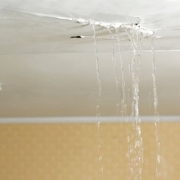Is Your Roof Leaking? Don’t Wait Until It’s Too Late!
If you are starting to hear a dripping sound, or suddenly notice a brown spot on your ceiling, that is a good indication that you have a roof leak. If finances are tight, it can be easy to say you’ll deal with it later, but the longer you put it off, the more serious the damage, and therefore, the resulting repair bill will be. If it goes too long, then you could be looking at an entire roof replacement, on top of fixing whatever interior damage the leak caused. Here’s a guide to help you determine what to look for, and what signs indicate it’s too late.
Signs to Watch For
Look for the following signs in your home to help you identify leaks or their potential to develop:
- Brown spots on the ceiling
- Water stains on the underside of the roofing deck or around the chimney
- Black stains on the roofing deck—this may be an indication of mold or mildew
- Bits and pieces of shingle in the yard
- Rust stains on the furnace flue
- Peeling paint or rotted wood around skylights
- Roof granules in the downspouts
If you notice these in your home, make sure you employ proper safety techniques, first. Inspect the attic, and go outside to inspect the roof at ground level for signs of damage.
Is it Too Late?
If your roof is flat, it is most likely to leak because the lack of pitch, but a flat roof should last anywhere between eight and 12 years. The more layers you have, the longer it will last. While a multi-layer roof will add the overall installation cost, you may be able to get an additional seven to eight years on the life of your roof.
If your roof is pitched, it can move water off faster, thereby preserving the shingles. However, all pitched roofs have their vulnerable spots. The use of water and ice shields along the gutter lines and in the valleys can help extend the life of your roof. Fixing a leak at the first sign of a problem can help keep your roof “living” longer.
If you have a house that is under either western or southern exposure, those areas of your roof will wear faster than the rest. This is because your home gets the most sun exposure in those areas, and the intense heat will degrade the roof there faster than it will in other areas that don’t get as much heat from the sun. Once you start to notice shingles buckling, there is not much you can do about it–you will have maybe one to to years of life left, and the other shingles won’t be too far behind it.
Remember, patching your roof will only work in certain situations. It will only temporarily solve the problem when the leaks are very small, or there is wind damage to your roof. However, if the roofing material itself is deteriorating, then you can only expect the problem to get worse with time, and the longer you wait, the more it will cost you. The cost of roofing, both in terms of material and labor, won’t be going down anytime soon, so a patch will only prolong the inevitable replacement.








Leave a Reply
Want to join the discussion?Feel free to contribute!